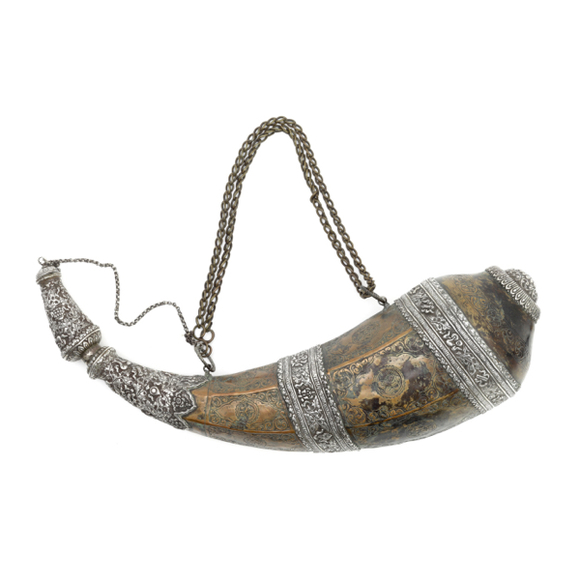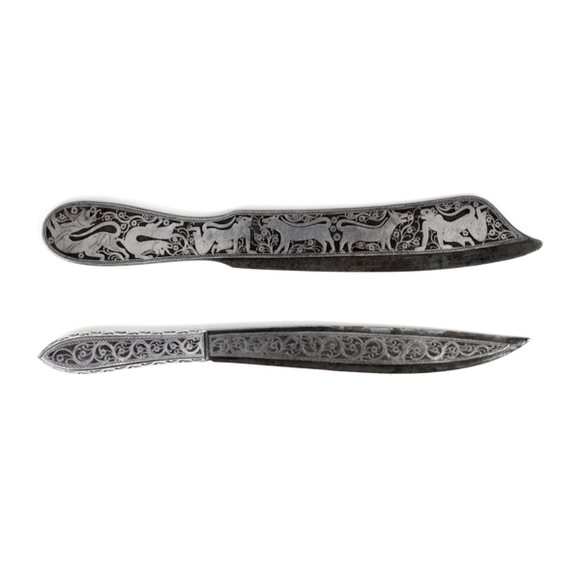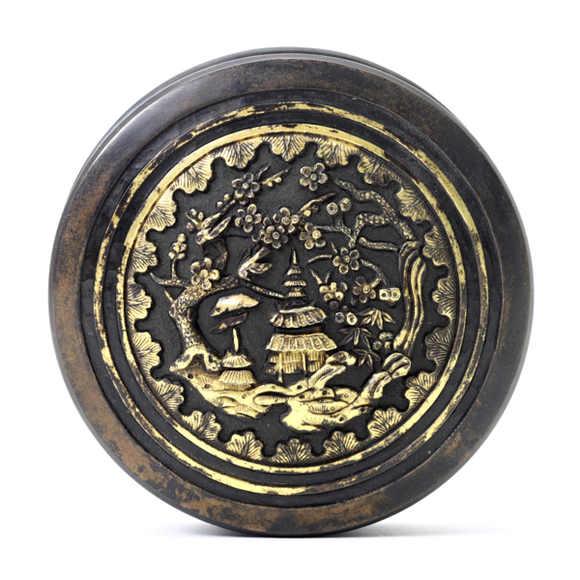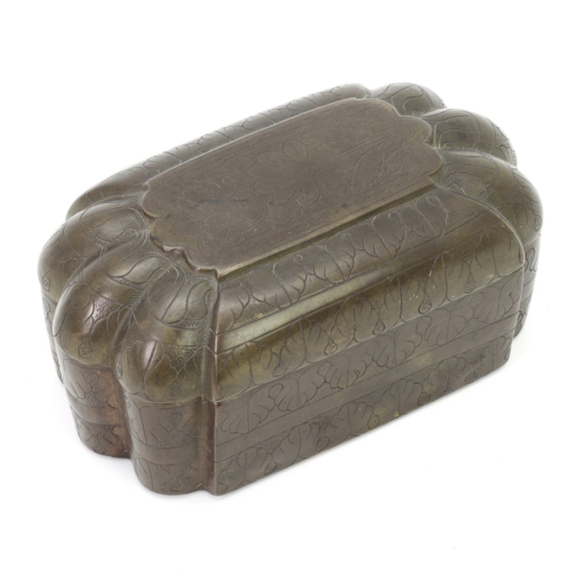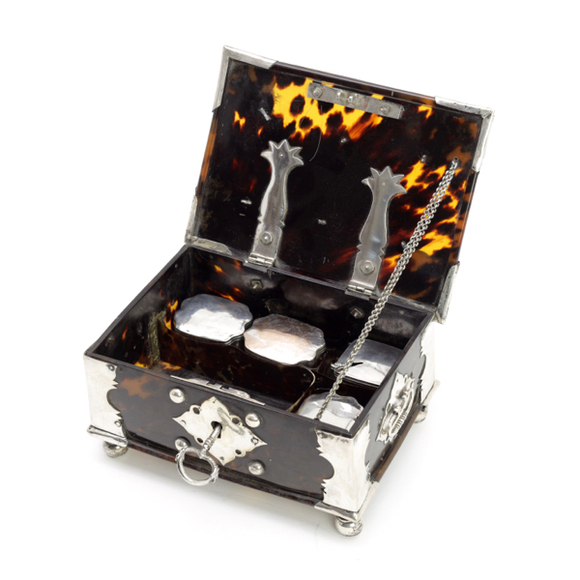Such work was made in the Royal workshops of Lhasa.

38 x 31 x 13 cm
Wood, lacquer, pigments
Canton or Fuzhou
Southern China
Circa 1800-1850
European antique art market
Introduction
Fine Asian lacquerware was initially exported to Europe from Japan. Japan's closing off for foreign trade, except for the Dutch and Chinese, gave a monopoly to the Dutch on the trade of lacquer.
By the 18th century, craftsmen in Southern China, mainly Canton, decided to jump into that gap and started producing lacquerware of European forms but with Asian decoration that was mainly traded with the British. As with most Asian export goods, black and gold was the preferred color scheme.
These pieces are today mostly found in British and American collections. Today, the Peabody Essex Museum in Salem houses one of the most comprehensive and well-provenanced examples of this work.
This example
A very good example of Cantonese lacquer work in the form of a box. The box is made of wood, octagonal in shape, with a cover with rounded edges. It has four wooden lion feet.

The lacquer shows scenes of a typical Southern Chinese scholar's garden with people in it, all done in black and gold with some small red highlights. Surrounding these scenes are typical Chinese decorative motifs incorporating several auspicious symbols such as coins, scrolls, etc.

Condition
Some cracks in the lacquer on the outside, minor losses on the inside lining. Main decorative surfaces mostly intact. See photos.
Monogram
The inside of the lid carries a monogram in gold over the black background.

A historical account
An 1875 account mentions a visit to a lacquerware factory in Canton:
"We now passed through the street called 西耒初地 Sai-Loi-Ch'oh-Ti. In this street, there are several shops in which Chinese furniture is on sale. Some of the articles in question, especially those, which are made of black wood and marble, and inlaid with mother of pearl, are very handsome, and, apparently, very costly.
In order that we might have the pleasure of visiting a lacqueredware factory, we followed the course of the street called 慶雲里 Hing-Wan-Li, and which conducted us to a lacqueredware hong named 協記漆器舖 Hip-Ki. Here, we saw three or four workmen engaged in covering the chinks, or crevices of small deal tea tables, tea caddies, work boxes, &c。, with strips of coarse brown paper. The paper was made to adhere to the articles, which we have enumerated, by means of a paste called Chue-liu, and which, as the name more or less implies, is made of the blood of pigs and well powdered cockle shells. The articles in question were, in the second instance, besmeared with a paste called Fui-Ni, and which is made of the dust of disintegrated granite and the blood of pigs. Disintegrated granite is, for this purpose, let it be
observed, brought in quantities to Canton, from the hills of Sai-Chu. The articles, when dry, are carried into a room from which both light and wind are, in some measure, excluded, and, are there, coated with a lacquer, termed Kum-Ts'at, and which, from the province of Sze-Chuen, is largely exported. The articles are then coated with a lacquer termed Min-Ts'at,
and which, from the aforesaid province, is, also, obtained. One coating of the last mentioned lacquer is generally deemed sufficient. With the view, however, of rendering the articles pre-eminently fine, three coatings of the lacquer in question, are not unfrequently applied to them. The articles are, then, removed to a neighbouring house 李家祠 where, by artists, they are painted, and gilded. The manner in which this is done, may be described as follows: — The artist has several
designs, which, by a very sharp pointed needle, have been traced on thin sheets of paper. He, having selected one of these designs, places it on the article, which requires to be painted and gilded. He, then, rubs the paper with a very
small thin pouch, or bag, in which well powder-ed chalk is contained. Portions of the powder in question find their way not only through the pores of the bag, but, also, through the many perforations which, by a sharp pointed needle, have been made in the paper. Thus, upon the article to be painted and gilded, there is formed, in lines of chalk dust, a perfect representation of the design.
The artist, now, takes in his hand a wire pencil, and by means of which, he, carefully following the lines of chalk dust, delineates, or scratches the design on the article, which it is his intention to paint, and gild. He, in the next instance, by the use of a paint to which, by a mixture of vermilion, a red colour has been imparted, paints on the article, the design which, by the wire pencil, he has previously traced. When the red colours, of which this design consists, have, in some measure, dried, he, then, dips into a small bowl containing gold dust, a piece of cotton to which, of course, portions of the gold dust readily adhere. He, now, uses this piece of cotton charged with gold dust, as a brush, and rubs it gently over the half dried picture, or design in red. To this picture or design in colours of red, the gold dust very closely adheres. Thus, when
this labour has been brought to a close, the artist has the satisfaction to see upon the article which he was told to paint, the design in colours of gold. In this, and, indeed, in all factories of a similar kind, very beautiful articles are produced."
From: John Henry Gray; Walks in the city of Canton.
Victoria, Hong Kong, De Souza & Co. 1875.
In the manufacture of lacquer-ware the lightest kinds of wood are used. After planing, the surface is covered with a coating of grasscloth fibre and Broussonetia paper, and a mixture of pigs' or buffaloes' gall and pulverised old red sandstone serves as a priming. The article is then placed in a dark room, and a coating of the prepared lacquer laid on with a brush and allowed to dry; and according to the fineness of the ware these coatings are repeated from 3 to 15 times. When the hut coat is dry the articles are painted and gilded. The lacquer, sap of the Vemix vemieiaf used in Canton, is imported from Szechuen or Kiangsi. The gold colouring (a solution of gold leaf in glue water) is laid on with lye of potash ; red is native cinnabar, pink a varnish prepared from Carthamus and green is formed by a mixture of hartall and indigo. Nearly all the lacquer-ware is manufactured in Canton, but magnificent specimens, far exceeding the Canton ware in beauty, colour and fineness are turned out at Foochow. They are made by a single family, said to be of Japanese origin, who brought the secret over with them and have retained it ever since.
From: Catalogue of the Chinese Imperial Maritime Customs Collection
at the United States International Exhibition, Philadelphia, 1876
Inspectorate General of Customs, 1876
Page 85

Painting of a lacquerware shop in Canton, circa 1820-1850.
Private collection.
















Sawasa is metalware in black and gold made primarily for the Dutch expat community in Asia.

